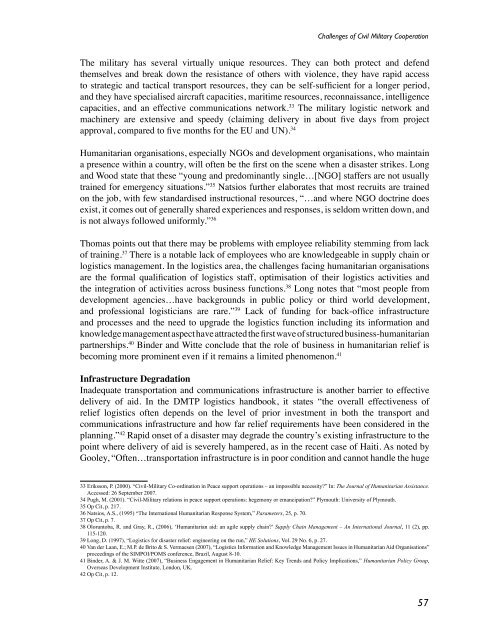Defence Forces Review 2010
Defence Forces Review 2010
Defence Forces Review 2010
Create successful ePaper yourself
Turn your PDF publications into a flip-book with our unique Google optimized e-Paper software.
Challenges of Civil Military CooperationThe military has several virtually unique resources. They can both protect and defendthemselves and break down the resistance of others with violence, they have rapid accessto strategic and tactical transport resources, they can be self-sufficient for a longer period,and they have specialised aircraft capacities, maritime resources, reconnaissance, intelligencecapacities, and an effective communications network. 33 The military logistic network andmachinery are extensive and speedy (claiming delivery in about five days from projectapproval, compared to five months for the EU and UN). 34Humanitarian organisations, especially NGOs and development organisations, who maintaina presence within a country, will often be the first on the scene when a disaster strikes. Longand Wood state that these “young and predominantly single…[NGO] staffers are not usuallytrained for emergency situations.” 35 Natsios further elaborates that most recruits are trainedon the job, with few standardised instructional resources, “…and where NGO doctrine doesexist, it comes out of generally shared experiences and responses, is seldom written down, andis not always followed uniformly.” 36Thomas points out that there may be problems with employee reliability stemming from lackof training. 37 There is a notable lack of employees who are knowledgeable in supply chain orlogistics management. In the logistics area, the challenges facing humanitarian organisationsare the formal qualification of logistics staff, optimisation of their logistics activities andthe integration of activities across business functions. 38 Long notes that “most people fromdevelopment agencies…have backgrounds in public policy or third world development,and professional logisticians are rare.” 39 Lack of funding for back-office infrastructureand processes and the need to upgrade the logistics function including its information andknowledge management aspect have attracted the first wave of structured business-humanitarianpartnerships. 40 Binder and Witte conclude that the role of business in humanitarian relief isbecoming more prominent even if it remains a limited phenomenon. 41Infrastructure DegradationInadequate transportation and communications infrastructure is another barrier to effectivedelivery of aid. In the DMTP logistics handbook, it states “the overall effectiveness ofrelief logistics often depends on the level of prior investment in both the transport andcommunications infrastructure and how far relief requirements have been considered in theplanning.” 42 Rapid onset of a disaster may degrade the country’s existing infrastructure to thepoint where delivery of aid is severely hampered, as in the recent case of Haiti. As noted byGooley, “Often…transportation infrastructure is in poor condition and cannot handle the huge33 Eriksson, P. (2000). “Civil-Military Co-ordination in Peace support operations – an impossible necessity?” In: The Journal of Humanitarian Assistance.Accessed: 26 September 2007.34 Pugh, M. (2001). “Civil-Military relations in peace support operations: hegemony or emancipation?” Plymouth: University of Plymouth.35 Op Cit, p. 217.36 Natsios, A.S., (1995) “The International Humanitarian Response System,” Parameters, 25, p. 70.37 Op Cit, p. 7.38 Oloruntoba, R. and Gray, R., (2006), ‘Humanitarian aid: an agile supply chain?’ Supply Chain Management – An International Journal, 11 (2), pp.115-120.39 Long, D. (1997), “Logistics for disaster relief: engineering on the run,” IIE Solutions, Vol. 29 No. 6, p. 27.40 Van der Laan, E.; M.P. de Brito & S. Vermaesen (2007), “Logistics Information and Knowledge Management Issues in Humanitarian Aid Organisations”proceedings of the SIMPOI/POMS conference, Brazil, August 8-10.41 Binder, A. & J. M. Witte (2007), “Business Engagement in Humanitarian Relief: Key Trends and Policy Implications,” Humanitarian Policy Group,Overseas Development Institute, London, UK.42 Op Cit, p. 12.57
















